TUESDAY, SEPTEMBER 1, 2015
Kodungallur was under sea till 900CE-ASI
Deva Priyaji Solomon
Deva Priyaji Solomon
P.Anujan Achan went in for detailed research 1947 and did not find any worthy articles in his Survey. ASI conducted detailed Researches in and around Kodungallore by Prof.Dr.Raman and Mr. K.V.Saundararajan, they went in for detailed research mainly because of the so called “Myurikodu” is called as Kodungallur in Jewish copper plate referred below said by Dr.Raman in his book.
Jewish Copper Plate -Issued by Baskara Ravi Varman is reportedly has “Myurikodu” Jewish Copper Plate, awarded by Bhaskara Ravi Varman I Perumal (962-1019 A.D.), is a Sasanam outlining the grant of rights of the Anjuvannam and 72 other properietary rights to local Jewish Chief Ousepp Irabban
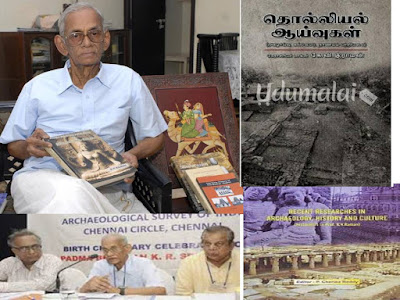
As Kerala Churches were continuously claiming that Kodungallore was Muzuris referred in Sangam Liturature, a detailed survey was conducted in and around Kodungallore and the result was all the articles collected in all the locations uniformly - cultural remains of iron and copper tools, glass beads, semi precious stones, ceramics of dull red ware, celadon ware roof tiles, earthen lamps and coins were all Radio Carbon dated to 9th or 10th Century CE and they reached Virgin soil without Human habitation by 9th Century CE.

K.V.Raman and K.V.Saundararajan (1969-70). Archaeological sites such as Cheraman Parambu, Thiruvanchikulam, Karuppadanna, Mathilakam, Kilatali and Thrikkulasekharapuram. Do we have the Copper Plates and are they really reliable. As per various researchers the original was taken by Rev.Cladius Buchanan took it to Britain - University of Cambridge and only the copy engraved in 19th century is is Kerala.


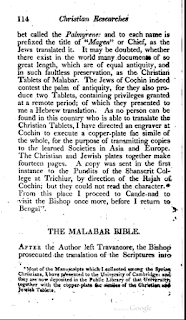
Claudius Buchanan words say that the copper plates does not have proper source and appeared suddenly and has no Historic value. Now do the Copper Plates really belong to Christians, no says researchers - A Social History of India - Page 422 S. N. Sadasivan - 2000 - India quotes E.Thurston and says they are issued to Trade groups, no names in these refers to Christians, Burnell and William Logan has also said Mani Gramam or Anjuvannam has nothing to do with Syrian Christians.


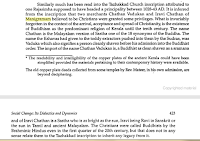
Historical Worth of these Copper plates are doubtful, and even if they were copies of orginals- issued in 9th and 14th Century has no relevance to Sangam period. Now comes another twist- A Malayalam Book which was awarded as best History book in 1984 by Kerala History Association- Ernakulam in 1984. (The History of Christianity in the Spice Land- P.V.Matthew) as informed in his book “Acta Indica” -1986 by Mr..K.C.Chacko, Ex Pro Vice Chancellor Calicut & Cochin Universities in his Foreword.

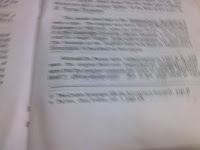
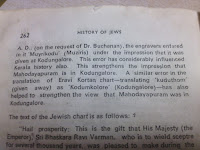
In this Book- "Acta India" Page No.261 & 262- Mr.P.V.Matthew says that Dr.Buchanan- asked the engravers to engrave “Muyrikodu” when his original had only Mahothaikod in Baskara Ravi Varman plate . and kodungallore in stead of “Koduthom” in Eravi Kotran plate
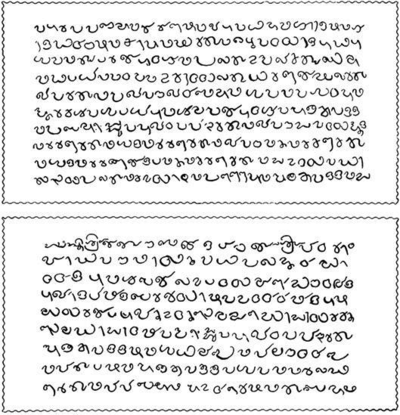

As per Stratigraphical Archaelogy by ASI in Kodungalure- and its surroundings include Cheraman Parambu. Thirukulasekarapuram, Thiruvanchikalam, Mathilakam etc, Human habitation started in 9th- 10th Century C.E. ONLY. They got virgin soil below.
Posted by Deva priyaji
TUESDAY, SEPTEMBER 1, 2015
கொடுங்கல்லூர் அகழ்வாய்வுகள் -இந்தியத் தொல்பொருள் துறை
கேரளாவின் கொடுங்கல்லுரில் முதலில் 1946ல் இந்தியத் தொல்பொருள் துறையின் மார்ட்டிமர் வீலரின் சீடர் திரு. அனுஜான் அச்சன் ஆய்வு செய்தார். கொடுங்கல்லுரின் தொன்மை 14ம் நூற்றாண்டிற்கு முன்பு செல்லவில்லை என்றார். பின்பு திரு.கே.வி..ராமன் மற்றும் திரு. சௌந்தரராஜன் தலைமையில் சேரமன் பறம்பு, திருவஞ்சிகுலம், கருப்பதனா, மதிலகம், கீழட்டலி & திருகுலசேகரபுரம் என கொடுங்கல்லூர் சுற்றி உள்ள அனைத்து பகுதிகளிலும் இந்தியத் தொல்பொருள் துறை சார்பாக நீண்ட ஆய்வுகள் நடந்தன. அதன் முடிவுகள்.

 கொடுங்கல்லூர் நகருக்குத் தெற்கில் பல இடங்களில், வடக்கில் பழமையானவை என்று கருத்ப்ப்ட்ட சில இடங்களிலும் அகழ்வாய்வுகள் மேற்கொள்ளப்பட்டது…. கேரளாவில் நடைபெற்ற இந்த அகழ்வாய்வுகளை நடுநிலை நின்று பார்த்தால் கீழ்கண்ட, தற்காலிகமான முடிவிற்கு வரலாம். கொடுங்கல்லூருக்கு உள்ளும் புறமுமாக, பல முக்கிய இடங்களிலும் நடத்தப்பட்ட அகழ்வாய்வுஅள் எல்லாவற்றிலும் கிடைத்த மிகப் பழைமையான படிவுகள் கி.பி.8 அல்லது 9-ஆம் நூற்றாண்டைச் செர்ந்த்ததாகத்தான் உள்ளன. ஆக, ஓரே சீரான பண்பாட்டுக் கூறுகள் எல்லா இடங்களிலும் வெளிப்பட்டுள்ளன என்பது தெளிவாகிறது. கொடுங்கல்லூர் பகுதியில், மனித சமுதாயத்தில் முதல் குடியிருப்புகள் 8,9-ஆம் நூற்றாண்டுகளில் தான் ஏற்பட்டிருக்க வேண்டும். குலசேகர மரபினர், கண்ணனூர்ப் பகுதியில் குடியேறி, அதைத் தங்களுடைய தலைநகராக கொண்ட பொழுது இந்தப் பகுதி முழுவதும் முக்கியத்துவம் பெற்றிருக்க வேண்டும். குலசேகர மரபினர்களைப் பற்றிய நல்ல காலக் கணிப்புகள் நமக்குக் கிடைத்திருக்கின்றன. ஆனால் அதற்கு முற்பட்ட காலத்தைச் சேர்ந்த எந்த விதமான ஆதாரமும் கிடைக்கவில்லை.. ..
கொடுங்கல்லூர் நகருக்குத் தெற்கில் பல இடங்களில், வடக்கில் பழமையானவை என்று கருத்ப்ப்ட்ட சில இடங்களிலும் அகழ்வாய்வுகள் மேற்கொள்ளப்பட்டது…. கேரளாவில் நடைபெற்ற இந்த அகழ்வாய்வுகளை நடுநிலை நின்று பார்த்தால் கீழ்கண்ட, தற்காலிகமான முடிவிற்கு வரலாம். கொடுங்கல்லூருக்கு உள்ளும் புறமுமாக, பல முக்கிய இடங்களிலும் நடத்தப்பட்ட அகழ்வாய்வுஅள் எல்லாவற்றிலும் கிடைத்த மிகப் பழைமையான படிவுகள் கி.பி.8 அல்லது 9-ஆம் நூற்றாண்டைச் செர்ந்த்ததாகத்தான் உள்ளன. ஆக, ஓரே சீரான பண்பாட்டுக் கூறுகள் எல்லா இடங்களிலும் வெளிப்பட்டுள்ளன என்பது தெளிவாகிறது. கொடுங்கல்லூர் பகுதியில், மனித சமுதாயத்தில் முதல் குடியிருப்புகள் 8,9-ஆம் நூற்றாண்டுகளில் தான் ஏற்பட்டிருக்க வேண்டும். குலசேகர மரபினர், கண்ணனூர்ப் பகுதியில் குடியேறி, அதைத் தங்களுடைய தலைநகராக கொண்ட பொழுது இந்தப் பகுதி முழுவதும் முக்கியத்துவம் பெற்றிருக்க வேண்டும். குலசேகர மரபினர்களைப் பற்றிய நல்ல காலக் கணிப்புகள் நமக்குக் கிடைத்திருக்கின்றன. ஆனால் அதற்கு முற்பட்ட காலத்தைச் சேர்ந்த எந்த விதமான ஆதாரமும் கிடைக்கவில்லை.. .. 

திருவஞ்சிக்களம் இங்கே நடந்த அகழ்வாய்வு கலவையான(Mixed) பல ஆதாரங்களை வெளிப்படுத்தியது. அவை மிகவும் பழைமையானவை 10 அல்லது 9ம் நுற்றாண்டுக்கு முற்பட்டதாக இல்லை.


திருவஞ்சிக்களம், கருப்பதானா அல்லது மதிலகம் போன்றவற்றின் பெயர்களை மட்டும் கொண்டு, அவைகள் பழைய வஞ்சியாகவோ கருராகவோ இருக்கலாம் என்று கருதப்பட்டது. ஆனால் இங்கு நடந்த அகழ்வாய்வுகள் கி.பி 8-ஆம் நூற்றாண்டைச் சேர்ந்த இரண்டாம் சேரப் பேரரசுக் காலத்து ஆதாரங்களைத் தான் வெளிப்படுத்தி உள்ளனவே அல்லாமல் பழங்காலச் சேரர்களை பற்றிய எந்தவிதமமன ஆதாரத்தையும் வில்லை. ஆகவே, இந்த இடங்களில் தான், பழைய வங்சியோ, கருரோ இருந்தது என்று சொல்ல முடிய வெளிப்படுத்தவில்லை. பழைய முசிறித் துறைமுகம் இருந்த இடத்தைக் கண்டுபிடிக்க வேண்டிய அவசியம் ஏற்பட்டிருக்கின்றது. அது நிச்சயமாக கொடுங்கல்லூராக இருக்க முடியாது. பக்-68-70 கே.வி..ராமன், தொல்லியல் ஆய்வுகள் and this article was earlier published in Araichi, 170, under the Heading “Archaeological Investigations in Kerala” This book is available for sale-as below தொல்லியல் ஆய்வுகள் (அகழாய்வு, கல்வெட்டு, நாணயம் பற்றியவை AUTHOR: பேராசிரியர் டாக்டர் கே.வி.இராமன் தொல்லியல் ஆய்வுகள் (அகழாய்வு, கல்வெட்டு, நாணயம் பற்றியவை இந்தியத் தொல்பொருள் துறையின் தென்மண்டலப் பிரிவுக் கண்காணிப்பாளராய் டாக்டர் கே.வி.இராமன் பல ஆண்டுகள் பணியாற்றினார். புதையுண்ட நகரங்களான நாகார்ஜுன கொண்டா, கொடுங்கல்லூர், பூம்புகார், காஞ்சி, மதுரை, குன்றத்தூர் முதலான இடங்களில் அகழ்வாய்வு செய்து அரிய செய்திகளைக் கண்டறிந்துள்ளார். பூம்புகாரில் இவரது நேரடிப் பார்வையில் நடைப்பெற்ற அகழ்வாய்வுகளும் கண்டுபிடிப்புகளும் அறிஞர்களால் பாராட்டப்பெற்றன. மேலும் UNESCO நிறுவனத்தினர் இவருக்கு விருதும் கேடயமும் வழங்கிச் சிறப்பித்துள்ளனர். காஞ்சி வரதராஜப் பெருமாள் கோவிலைப் பற்றி இவர் எழுதிய ஆராய்ச்சி நூலுக்காக, சென்னைப் பல்கலைக்கழகம் டாக்டர் பட்டம் வழங்கியுள்ளது. இவரது ’பாண்டியர் வரலாறு’ என்ற நூலினைத் தமிழ்நாட்டுப் பாடநூல் நிறுவனம் வெளியிட்டுள்ளது. 2011-இல் தமிழ்நாடு வரலாற்றுப் பேரவை அவருக்கு ‘தனிச்சிறப்புமிக்க புகழ்மிகு தொல்லியலாளர்’ என்னும் வெகுமதி பட்டத்தினை வழங்கி கெளரவித்தது.
For further reading https://groups.yahoo.com/neo/groups/IndiaArchaeology/conversations/topics/12432 http://haindavakeralam.com/HkPage.aspx?PAGEID=13876&SKIN=C
கொடுங்கலூர் பகுதிகள் கடலுக்கு அடியில் இருந்தது என்பதை கிறிஸ்துவ சர்ச்சும் உறுதிப் படுத்தியுள்ளது. History of Christianity in India, Vol. I, by Fr. A. Mathias Mundadan, Professor of Church History and Theology at the Dharmaram Pontifical Institute, Bangalore, in says Opinion seems to be Unanimously in supporting the Hypothesis that the whole or Greater part of the western section of the Kerala coast was once under waters and that the formation of the Land was due to some process of nature either gradual or Sudden. Page-12
Kodungallore Church are also called MALANKARA. What Does MALANKARA Mean?
The Tamil word correct form is Mal-Iyan Karai, which became Maliankara or Malankara.
The Land formed By God Vishnu(Mal) and God Siva(Iyan).
Posted by Deva priyaji
Deva priyajiSeptember 1, 2015 at 1:15 AM The so-called copper plates: Cladius Buchanan recorded as follows: “But there are other ancient documents in Malabar, not less interesting than the Syrian Manuscripts. The old Portuguese historians relate, that soon after the arrival of their countrymen in India, about 300 years ago, the Syrian Bishop of Angamalee (the place where I now am) deposited in the Fort of Cochin, for safe custody, certain tablets of brass, on which were engraved rights of nobility, and other privileges granted by a Prince of a former age ; and that while these Tablets were under the charge of the Portuguese, they had been unaccountably lost, and were never after heard of. Adrian Moens, a Governor of Cochin, in I770 who published some account of the Jews of Malabar, informs us that he used every means in his power, for many years, to obtain a sight of the famed Christian Plates ; and was at length satisfied that they were irrecoverably lost, or rather, he adds, that they never existed. The Learned in general, and the Antiquarian in particular, will be glad to hear jthat these ancient Tablets have been recovered within this last month by the exertions of Lieutenant- (Colonel Macauley, the British Resident in Travan-core, and are now officially deposited with that Officer. ‘ The Christian Tablets are six in number. They are composed of a mixed metal. The engraving on the largest plate is thirteen inches long, by about four broad. They are closely written, four of them on both sides of the plate, making in all eleven pages. On the plate reputed to be the oldest, there is writing perspicuously engraved in nail-headed or triangular- headed letters, resembling the Persepolitan or Babylonish. On the same plate there is writing in another character, which is supposed to have no affinity with any existing character in Hindoo* tan. The grant on this plate appears to be witnessed by four Jews of rank, whose names are distinctly engraved in an old Hebrew character, resembling the alphabet called the Palmyrene: and to each name is prefixed the title of ‘ Alagen,’ or Chief, as the Jews translated it. — It may be doubted, whether there exist in the world many documents of so great length, which are of equal antiquity, and in such faultless preservation, as the Christian Tablets of Malabar. — The Jews of Cochin indeed contest the palm of antiquity: for they also produce two Tablets, containing privileges granted at a remote period; of which they presented to me a Hebrew translation. As no person can be found in this country who is able to translate the Christian Tablets, I have directed an engraver at Cochin to execute a copper-plate facsimile of the whole, for the purpose of transmitting copies to the learned Societies in Asia and Europe. The Christian and Jewish plates together make fourteen pages. A copy was sent in the first instance to the Pundits of the Shanscrit College at Trichiar, by direction of the Rajah of Cochin ; but they could not read the character.* — From this place I proceed to Cande-nad, to visit the Bishop once more before I return to Bengal.’ [Claudius Buchanan, Two Discourses preached before the University of Cambridge, on the commencement of Subday July 1, 1810 and a sermon before the Society of Missions to Africa and the East; at their tenth anniversary. June 12, 1810. To which added Christian Researches in Asia, T. Cadell and W. Davies, in the Strand; and J. Deighton, Cambridge, London, 1811, pp.121-122.
6. In footnote, he recorded, “Most of the Manuscripts which I collected among the Syrian Christians, I have presented to the University of Cambridge; and (they are now deposited in the Public Library of that University, together with the copper-plate fac-similes of the Christian and Jewish Tablets.” (Ibid. P.122). Thus, it is evident that there were no originals of the said copper plates and thus, the available / claimed copper plates have no historical value.
Read more: http://www.nasrani.net/2007/02/16/the-plates-and-the-privileges/#ixzz3kTNXM4PA Reply
Deva priyaji September 1, 2015 at 1:18 AM
Now I refer again Dr.Joseph Kolangodan wrote a book The History of Apostle Thomas and it has the total appraisal from a fellow Christian, Professor John Ochanthurthi, Dept. of History, Calicut University
As far as I could see from all the Shreds of Quotations presented by Prof. Kolangadan in this Volume, the antiquity of St.Thomas Tradition in South India cannot go beyond 13th Century. So far as direct and explicit support in favour of the St.Thomas Tradition in South India is concerned, I have No Doubt that the answer must be, None. Neither the Church Fathers nor the Apocrypal Acts say anything explicityly about Malabar. Page 79
I quote from Rev.George Menachery Edited St. Thomas Christians Encyclopedia ,Vol-2, Article DID St.Thomas Really Come to INDIA- From a Doubter s point of View by Rev H.COMES. It explains-
Heracleon- (II Century) is the earliest author to throw a light on St.Thomas s carrier; his grandparents might have known the Apostle. Now, discussing the problem of witness and blood martyrdom, he states in a casual way, as something well known, that Matthew, Philip, Thomas, and Levi(Thaddaues) had not met violent deaths. And Clement of Alexandria (150-211/16 A.D.) who quotes this Passage of Heracleon and corrects some of his ideas, does not challenge this facts.
It explains and analyses further in detail all other points and finally concludes as- " For all these reasons it is our honest opinion, and thus we conclude, that Christianity was brought to India, not by St.Thomas, but by merchants, refugees and missionaries from Persia; that in this movement of Christianity towards India, Rewardshir, which was not only a great church, but also a great port, played an important part; that the St.Thomas Tradition itself may have been brought to Socotra to Konkan -Gujarat and to South India by these early settlers and missionaries from Persia; but that its ultimate origin may have been some of the regions near Palestine Christianized in the First Century." Page-24